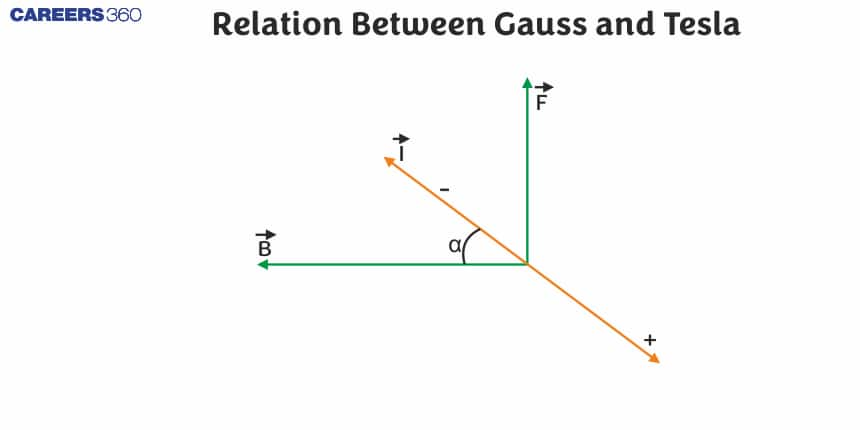Relation Between Gauss and Tesla - A Complete Guide
Gauss and Tesla are units widely used for measuring the magnetic flux density essential in the study of electromagnetism. Tesla, the SI unit, represents larger magnetic fields; in contrast, Gauss is a CGS unit for smaller fields. The relation between them, that is, 1 Tesla = 10,000 Gauss, establishes a connection between the two systems of measurement. It becomes more important when one has to analyze a magnetic field for various applications in physics.
JEE Main/NEET 2027: Physics Important Formulas for Class 10
NEET 2025: Mock Test Series | Syllabus | High Scoring Topics | PYQs
JEE Main: Study Materials | High Scoring Topics | Preparation Guide
JEE Main: Syllabus | Sample Papers | Mock Tests | PYQs

What is Gauss?
Gauss is the unit of magnetic induction in the CGS system. It is named after Carl Friedrich Gauss, a famous German physicist.
The base unit of Gauss is,
1 gauss is defined as 1dyne of force which exerts on a charge of 1emu which moves in velocity of 1cm/s in the magnetic field perpendicularly.
What is Tesla?
Tesla is a unit of magnetic field intensity or magnetic induction. In other words, the SI unit of magnetic induction is Tesla or it. It is usually denoted by T. This unit is named after Nikola Tesla, the famous American physicist.
Tesla
1 Tesla is defined as the intensity of a magnetic field which generates a force of 1Newton per current of 1Ampere and a conductor of one meter.
So 1 Tesla is equal to 1N of force which exerts on coulomb of charge of 1C which moves in velocity of 1m/s in the magnetic field perpendicularly.
Also, read
- NCERT Solutions for All Subjects
- NCERT Notes For All Subjects
- NCERT Exemplar Solutions for All Subjects
Relation Between Gauss and Tesla
We are all aware of the attraction and repulsion forces upon a charge entering an electric or magnetic field. Now suppose some moving charge particle enters into the magnetic field then the size of the force experienced or acting on that charged particle is called the intensity of magnetic field or sometimes we will call it Magnetic Induction, which can be calculated using Lorentz as:
or,
Here, F = Lorentz force(F)
From equation (1), we can derive, the magnitude of magnetic field intensity as,
And, the units of this magnetic field intensity are Gauss or Tesla, depending upon the units system considered for the calculation and both the units are also interrelated to each other.
This relation between Gauss and Tesla helps us convert from one unit to another and vice versa and will be proved to be convenient while doing calculations.
Related Topics |
The formula of Gauss Law and Tesla
Tesla is a bigger unit than Gauss. The interrelations between Gauss and Tesla can be expressed mathematically as,
From Tesla to Gauss
- 1 Tesla
From Gauss to Tesla
- 1 Gauss
Here are some of the most commonly used units for the measurements of magnetic flux density.
1 Tesla
100 Gauss
Conversion of Gauss to Tesla or Tesla to Gauss
The Conversion of Gauss to Tesla or Tesla to Gauss is quite simple as both are directly proportional. Tesla is a big unit that can be converted into small units.
1 tesla is equal to how many gauss?
1Tesla is 1N of force which exerts on coulomb of charge of 1C which moves in velocity of 1m/s in the magnetic field perpendicularly.
1Tesla = 1N /(1C * 1m/s)
We know that
1N = 105 dyne
1C = 10-1 emu
1m/s = 102 cm/s
1Tesla = 105 dyne/(10-1 emu*102 cm/s)
1Tesla = 104 dyne/(emu*cms)
1Tesla = 104 gauss
Therefore, one tesla is equal to 104gauss.
Conversion of 1 gauss to tesla:
1 gauss is equal to 10-4 Tesla.
Frequently Asked Questions (FAQs)
Magnetic field strength
Solution:
The magnetic field intensity (H) is also called magnetic field strength, magnetic intensity. The magnetic field intensity is defined as, the force experienced by a unit north pole at that point in the magnetic field. The magnetic field intensity or magnetic induction can be calculated using Lorentz force.
F=V×q×B×sinθ
So from this equation, we can calculate magnetic induction by rearranging the equation as
B= F/(V×q×sinθ)
1Tesla
1Tesla is 1N of force which exerts on coulomb of charge of 1C which moves in velocity of 1m/s in the magnetic field perpendicularly.
1 Tesla = NA m/s.
1gauss
1gauss is defined as 1dyne of force which exerts on a charge of 1emu which moves in velocity of 1cm/s in the magnetic field perpendicularly.
1 gauss = 1dyne(1emu×1cm/s)
Conversion of tesla to gauss
1Tesla = 1N /(1C * 1m/s)
We know that
1N = 105 dyne
1C = 10-1 emu
1m/s = 102 cm/s
1Tesla = 105 dyne/(10-1 emu*102 cm/s)
1Tesla = 104 dyne/(emu*cms)
1Tesla = 104 gauss
Tesla SI unit of magnetic induction.
10gauss = 0.001 Tesla
Tesla to gauss
Solution
Gauss to tesla is usually preferred because the gauss(CGS) system is the measuring system for only 3units length, mass, time. But the Tesla (SI) is the measuring system for not only 3units it has around 7units. So gauss which has only 3dimensional measuring units is usually preferred than tesla units for easy measurement as this SI unit will lead to 4dimension.
Also Read
02 Jul'25 05:02 PM
02 Jul'25 04:46 PM
02 Jul'25 04:46 PM
02 Jul'25 04:33 PM
02 Jul'25 04:31 PM
02 Jul'25 04:31 PM
02 Jul'25 04:29 PM
02 Jul'25 04:26 PM
02 Jul'25 04:25 PM

